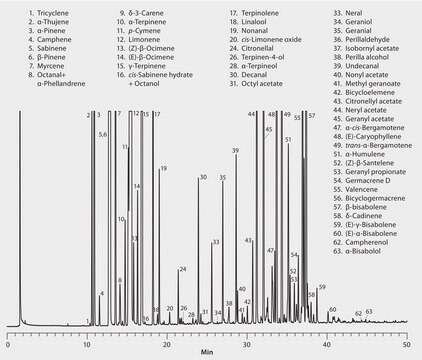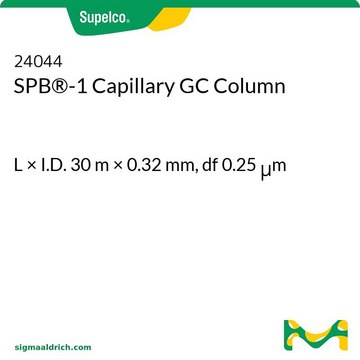24255
SPB®-624
L × I.D. 30 m × 0.25 mm, df 1.40 μm
Sinónimos:
SPB-624, 30M .25MM 1.4UM
Iniciar sesiónpara Ver la Fijación de precios por contrato y de la organización
About This Item
UNSPSC Code:
41115710
eCl@ss:
32119290
Productos recomendados
material
fused silica
Quality Level
agency
EPA 524.2,0030,624,8260,OLM04.2 VOA
meets requirements for USP G43
suitable for EPA 601
parameter
≤25-250 °C temperature (isothermal or programmed)
Beta value
45
df
1.40 μm
technique(s)
gas chromatography (GC): suitable
L × I.D.
30 m × 0.25 mm
application(s)
environmental
food and beverages
pharmaceutical
column type
capillary intermediate polar
¿Está buscando productos similares? Visita Guía de comparación de productos
General description
Application: This column is specially tested for separation, efficiency, and low bleed. It is designed for purge-and-trap analyses of volatile halogenated, non-halogenated, and aromatic contaminants from environmental samples.
USP Code: This column meets USP G43 requirements.
Phase:
USP Code: This column meets USP G43 requirements.
Phase:
- Bonded
- Proprietary
- ≤0.32 mm I.D.: Subambient to 250 °C (isothermal or programmed)
- ≥0.53 mm I.D.: Subambient to 230 °C (isothermal or programmed)
Application
SPB®-64 fused silica capillary column may be used in gas chromatography quipped with flame ionization detector (FID) in order to measure styrene level in the blood and in the cochlear samples, in an investigation to determine the distribution of styrene in the cochlea, to monitor the hearing loss and death of cochlear cells in different regions as a result of varying styrene dosage and to analyse the relative vulnerability of cochlear cells and cell death pathways after styrene exposure as styrene is ototoxic and causes cochlear damage starting from the middle turn.
Other Notes
We offer a variety of chromatography accessories including analytical syringes
Legal Information
SPB is a registered trademark of Merck KGaA, Darmstadt, Germany
Elija entre una de las versiones más recientes:
¿Ya tiene este producto?
Encuentre la documentación para los productos que ha comprado recientemente en la Biblioteca de documentos.
Los clientes también vieron
Guang-Di Chen et al.
Toxicological sciences : an official journal of the Society of Toxicology, 98(1), 167-177 (2007-04-11)
It is known that styrene is ototoxic and causes cochlear damage starting from the middle turn. However, the cellular mechanism underlying styrene ototoxicity is still unclear. In this study, rats were exposed to styrene by gavage at different doses once
Chromatograms
suitable for GCsuitable for GCsuitable for GCNuestro equipo de científicos tiene experiencia en todas las áreas de investigación: Ciencias de la vida, Ciencia de los materiales, Síntesis química, Cromatografía, Analítica y muchas otras.
Póngase en contacto con el Servicio técnico










